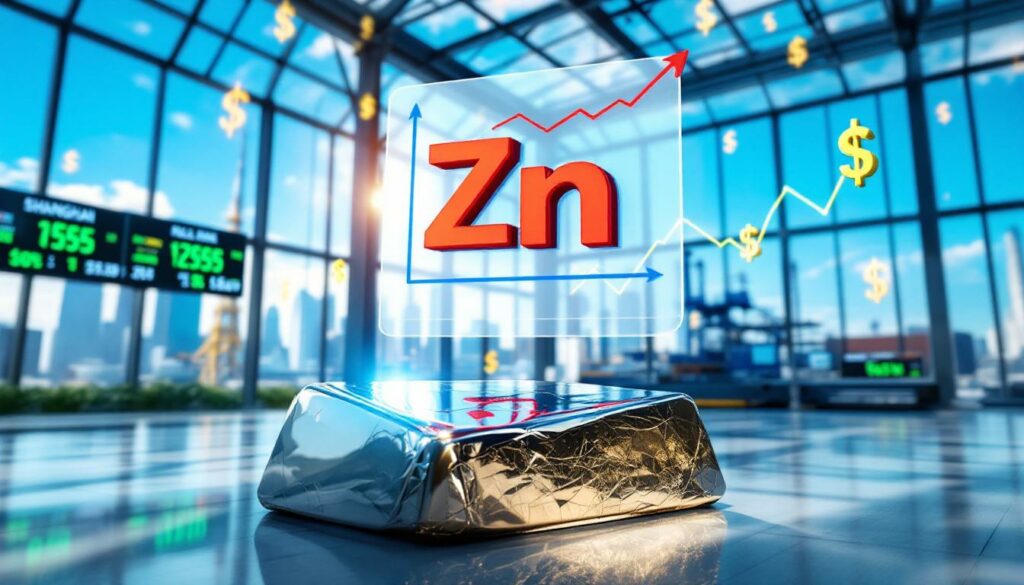What's Driving the Current Zinc Price Movement?
The London Metal Exchange (LME) zinc prices have been showing notable upward momentum, with significant gains recorded in recent trading sessions. On July 10, 2025, LME zinc closed at $2,777/mt, gaining $34.50/mt or 1.26% in a single session. This robust performance comes amid several key market dynamics affecting both global and domestic Chinese zinc markets.
Critical Supply-Demand Fundamentals
The primary factor supporting the current zinc price movement is the ongoing decline in global inventory levels. LME zinc inventory decreased by 1,100 mt to 105,600 mt (a 1.03% decline), continuing a months-long downward trajectory. This inventory reduction is particularly significant given the minimal growth in overseas refined zinc production capacity.
"The excessively low zinc ingot inventory has created a fundamental price floor for the metal," according to SMM analysis.
The persistent shortage of zinc ingots in international markets stands in stark contrast to the Chinese domestic situation, creating a notable market imbalance. Meanwhile, Shanghai Futures Exchange (SHFE) zinc contracts closed at 22,440 yuan/mt, up 55 yuan/mt (0.25%), showing more modest gains compared to the LME.
Trading volumes have surged significantly, with overnight LME trading reaching 13,460 lots, indicating heightened market interest and activity. This increased participation, coupled with declining open interest, suggests potential short-covering activity as traders reassess fundamentals.
How Are Global Macroeconomic Factors Influencing Zinc Prices?
The zinc market, like other base metals, remains highly sensitive to broader macroeconomic signals, particularly regarding monetary policy and international trade relations.
Interest Rate Cut Expectations
Recent statements from key monetary authorities have provided additional support for base metal prices. San Francisco Fed President Mary Daly has indicated consideration of interest rate cuts in fall 2025, stating a belief that two rate cuts could materialize before year-end.
"Fluctuating rate cut expectations throughout 2025 have provided underlying support for base metal prices, creating a favorable backdrop for zinc's recent performance," notes SMM's analysis.
This monetary policy outlook has significant implications for zinc and other dollar-denominated commodities. When interest rates decline, the dollar typically weakens, making these commodities more affordable for buyers using other currencies. Additionally, lower rates reduce financing costs for metal stockholding, potentially increasing physical demand and market liquidity.
International Trade Dynamics
The zinc market is also navigating complex international trade developments across multiple fronts:
- Ongoing US-China communications across multiple economic sectors
- Reports indicating Vietnam's disagreement with proposed tariff increases (from 11% to 20%)
- The US Commerce Secretary's upcoming visit to Japan potentially affecting metal trade flows
- EU-China tensions regarding medical device procurement restrictions, particularly for contracts exceeding 45 million yuan
These evolving trade dynamics create both risks and opportunities for zinc market participants, influencing everything from shipping costs to import/export regulations. The current US economic outlook and potential tariff impact insights remain critical factors for commodity markets globally.
What's Happening in Regional Zinc Markets?
Despite the strength in futures markets, regional spot markets across China show divergent behavior, with cautious sentiment prevailing among buyers.
Shanghai Market Conditions
In Shanghai, downstream buyers have adopted a strong wait-and-see approach despite the futures rally. Spot purchasing enthusiasm remains subdued, with trading primarily dominated by traders rather than end-users. Perhaps most tellingly, spot premiums continue declining, indicating persistent buyer hesitation.
"Market participants appear unwilling to chase prices higher, preferring instead to draw down existing inventories," reports SMM market observers.
Guangdong Market Dynamics
Guangdong's zinc market reveals a similar pattern of buyer caution:
- Just-in-time procurement strategies dominating buyer behavior
- Contracting price spread between futures contracts
- Declining spot premiums and discounts
- Overall poor trading performance despite futures market strength
This discrepancy between futures optimism and spot market caution highlights the complex psychology currently governing the zinc market.
Tianjin and Ningbo Markets
In northern markets, Tianjin traders have been forced to lower premiums to facilitate sales amid persistent buyer caution. Meanwhile, in Ningbo, some traders have begun pre-selling zinc ingots at lower prices, signaling bearish short-term expectations.
Downstream buyers across these regions are primarily utilizing existing inventory rather than making new purchases, with high price levels deterring significant spot market activity. This strategic inventory management suggests industrial users remain unconvinced of sustained higher prices.
How Are Inventory Levels Affecting Market Sentiment?
Inventory dynamics remain perhaps the most critical factor in current zinc price action, with global and domestic Chinese inventories telling contrasting stories.
Global Inventory Trends
LME zinc inventories continue their downward trajectory, falling by 1,100 mt to reach 105,600 mt, representing a 1.03% decline. These historically low global inventory levels provide fundamental price support that cannot be ignored by market participants.
The limited production growth in international markets has created persistent supply-side constraints, maintaining inventory-to-consumption ratios below historical averages. This tightness creates asymmetric price risk, with potential supply disruptions having magnified impact given the minimal buffer available.
Chinese Inventory Situation
In stark contrast to global trends, Chinese domestic inventories continue rising. Total zinc ingot inventory across seven SMM-monitored locations reached 90,300 mt, representing:
- A week-on-week increase of 7,200 mt from July 3
- A day-on-day increase of 1,200 mt from July 7
This divergence between rising domestic Chinese inventories and falling global stocks creates a complex market narrative, with potential arbitrage opportunities emerging between international and domestic markets.
"The inventory divergence reflects China's robust production capacity versus constrained international supply, creating distinct price dynamics across regions," explains SMM's market analysis.
What's Supporting SHFE Zinc Prices?
Despite relatively weak domestic spot market conditions, SHFE zinc prices have maintained resilience, supported by several key factors.
Domestic Policy Influences
Anti-cut-throat competition policies in China have bolstered industrial metal prices broadly, creating positive sentiment that has spilled over to zinc. The strong performance in black commodity markets (iron ore, steel, etc.) has provided additional support to the non-ferrous complex.
"Benefiting from anti-cut-throat competition policies in China, black commodities continued to rally, driving SHFE zinc prices higher," notes SMM's market commentary.
This regulatory environment has created more stable pricing conditions, reducing the aggressive pricing strategies that previously undermined sustainable market dynamics. Recent iron ore trends also highlight the interconnected nature of industrial commodity markets.
Technical Market Factors
From a technical perspective, several factors have contributed to SHFE zinc's resilience:
- LME zinc retracing to the 5/10-day moving average
- SHFE zinc recording a small bullish candlestick pattern
- Increased LME trading volume (13,460 lots) indicating heightened market interest
- Decreased open interest suggesting potential short-covering activity
These technical indicators point to consolidation with upward bias, particularly if macro factors remain supportive.
What's the Short-Term Outlook for Zinc Prices?
Analyzing the confluence of fundamental, technical, and macroeconomic factors provides insights into zinc's likely price trajectory in coming sessions.
Price Forecast Analysis
LME zinc is expected to maintain support from critically low global inventories, with technical resistance at recent highs near $2,784/mt. Meanwhile, SHFE zinc is anticipated to consolidate with an upward bias, influenced by both international dynamics and domestic policy developments.
The potential for continued divergence between Chinese and international markets remains high, with arbitrage opportunities possibly emerging if the spread widens further. Technical indicators suggest constructive momentum, particularly if LME prices can sustain levels above the 10-day moving average. For a comprehensive understanding, analysts often examine price forecast insights across related commodities.
"It is expected that SHFE zinc will mainly consolidate with a bias towards holding up well in the near term," according to SMM forecasts.
Market Sentiment Indicators
Several key sentiment indicators warrant close monitoring:
- Traders reducing bearish positions in both LME and SHFE markets
- Institutional investors reassessing fundamental supply constraints
- Producer hedging activity remaining subdued at current price levels
- Consumer buying interest potentially increasing if prices stabilize
The interplay of these sentiment factors will likely determine whether recent gains represent a sustainable shift in market dynamics or merely a temporary repricing.
FAQ: Understanding the Zinc Market
Why are low inventories so important for zinc prices?
Low inventories create a supply cushion shortage, meaning any unexpected demand increase or supply disruption can cause rapid price movements. With LME zinc inventories at 105,600 mt and continuing to decline, the market has minimal buffer against supply shocks, creating a fundamental support level for prices.
This inventory-to-consumption ratio is a critical metric for industrial metals, with lower ratios typically correlating with higher price volatility and upside risk. The current ratio remains well below historical averages, suggesting continued price support absent significant demand destruction.
How do interest rate expectations affect zinc prices?
Interest rate cuts typically weaken the US dollar, making dollar-denominated commodities like zinc more affordable for buyers using other currencies. Additionally, lower rates reduce financing costs for metal stockholding, potentially increasing physical demand.
San Francisco Fed President Mary Daly's comments about potential rate cuts in fall 2025 have contributed to zinc's price strength by improving the overall investment case for industrial metals. The anticipation of two potential rate cuts before year-end creates a constructive monetary backdrop for commodity markets generally.
What's causing the divergence between Chinese and international zinc markets?
The divergence between rising Chinese inventories (+7,200 mt week-on-week) and falling international stocks (-1,100 mt) reflects several structural factors:
- China's robust production capacity versus constrained international supply
- Different demand recovery rates across regions
- Logistical challenges in moving metal between markets due to shipping costs and import regulations
- Regional policy differences affecting production economics
This regional imbalance creates potential arbitrage opportunities while highlighting the increasingly fragmented nature of global commodity markets. The broader mining industry evolution continues to influence these market dynamics.
How might zinc prices perform through the remainder of 2025?
The market shows fundamental support from low global inventories and limited production growth, suggesting a floor for prices. However, economic uncertainty, potential trade tensions, and fluctuating interest rate expectations may create volatility.
Technical analysis indicates consolidation with an upward bias is the most likely near-term scenario, particularly if macroeconomic conditions remain supportive. The key factors to monitor include:
- Evolution of inventory levels across regions
- Changes in production capacity utilization
- Downstream demand signals, especially from galvanizing and die-casting sectors
- Central bank policy developments, particularly regarding the pace of interest rate adjustments
Investors should remain attentive to these variables when formulating zinc market strategies for the remainder of 2025.
Disclaimer: This market analysis is based on data available as of July 11, 2025, and represents current conditions. Future market developments may differ substantially from projections. Readers should conduct their own research before making investment decisions based on this information.
Ready to Stay Ahead of ASX Mineral Discoveries?
Discover how to position yourself ahead of the market with real-time alerts on significant ASX mining opportunities by exploring Discovery Alert's dedicated discoveries page, where the proprietary Discovery IQ model transforms complex mineral data into actionable investment insights.




